In part one of this in-depth look at how marketers and brands can minimise their traffic dependency on Google search, Ann Stanley of Anicca Digital explored the opportunities offered by social search. In the second part she examines the ways in which generative AI – typically presented as a threat – can offer solutions as well.
Generative AI and its impact on Search
While Machine Learning and Generative AI has been used in marketing for several years, it was the launch of ChatGPT by OpenAI in November 2022 that truly captured the industry’s (and world’s) attention. The released highlighted both the benefits and potential risks of being able to use a simple chat interface or text prompt to find answers and generate content.
This inspired a rapid race of developments across Google, ChatGPT and Bing:
- The rapid adoption of ChatGPT reportedly set off alarm bells at Google. The giant was caught off-guard by the overwhelming popularity of this tool.
- The big question was whether Google searchers would switch to ChatGPT? Then how other search engines would evolve and incorporate Generative AI.
- Things changed again when Microsoft updated Bing to incorporate ChatGPT functionality within their search engine. This option was made possible by their large investment in OpenAI.
- Google’s response was to launch Bard. This was marred during the launch demonstration when Bard provided a wrong answer. It had “hallucinated” at the worst possible time.
- As well as Bing, other search engines including Perplexity.ai and You.com added AI to their results.
- Bard never really recovered or caught up with ChatGPT. Bard was thus rebranded as Gemini, to disassociate it with the tarnished name.
- Google could then use Generative AI answers in its own search results, leading to a new age of search engines.
Google’s Search Generative Experience (SGE)
In May 2023, Google started to test Search Generative Experience (SGE) in their Labs environment. This was done by inserting Generative AI answers above the normal organic search listings.

The SGE results provided users with richer, more contextualised information. Data quickly revealed a concerning drop in traffic to the top organic listings. Either results were pushed down the page by SGE, or the user found the information in the SGE results.
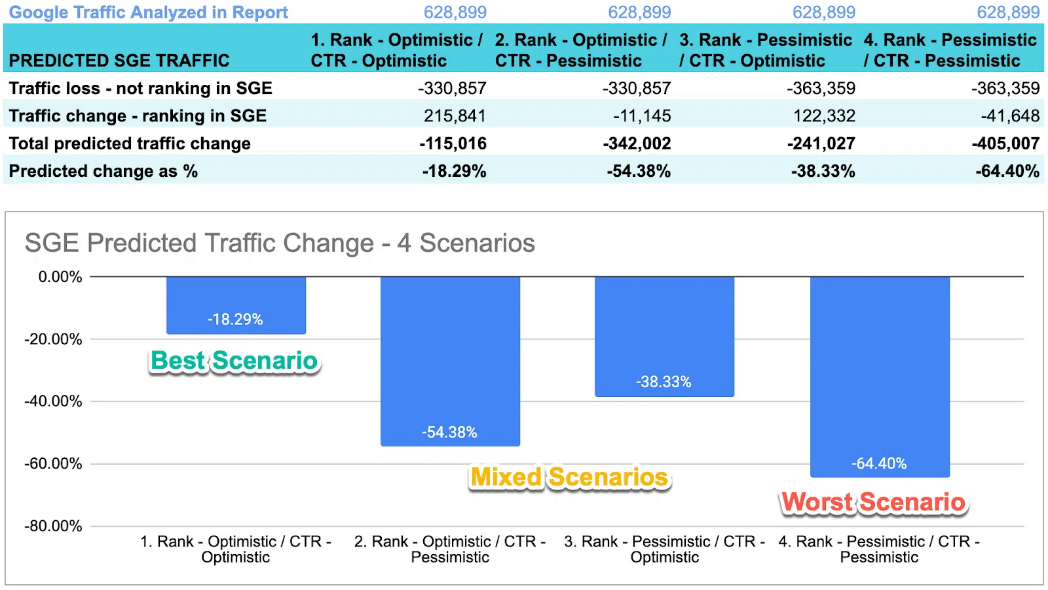
AI Overviews
Google launched its live version of SGE in the USA on the 14th March. Its new name was “AI Overviews.”
Below are some examples of AI Overview results grabbed on the 23rd May, though these results are no longer available. Live results have been scaled back due to public complaints about quality, compared to featured snippets and traditional organic results.
One obvious problem is that the top company listed in the screen grab below, is actually an American SEO agency. It has a page on its website for every city in the UK, but a USA phone number and case studies.
The other issue is that the text at the top can not be clicked on. The content is therefore taken from the website source, though only the three links at the bottom are active.
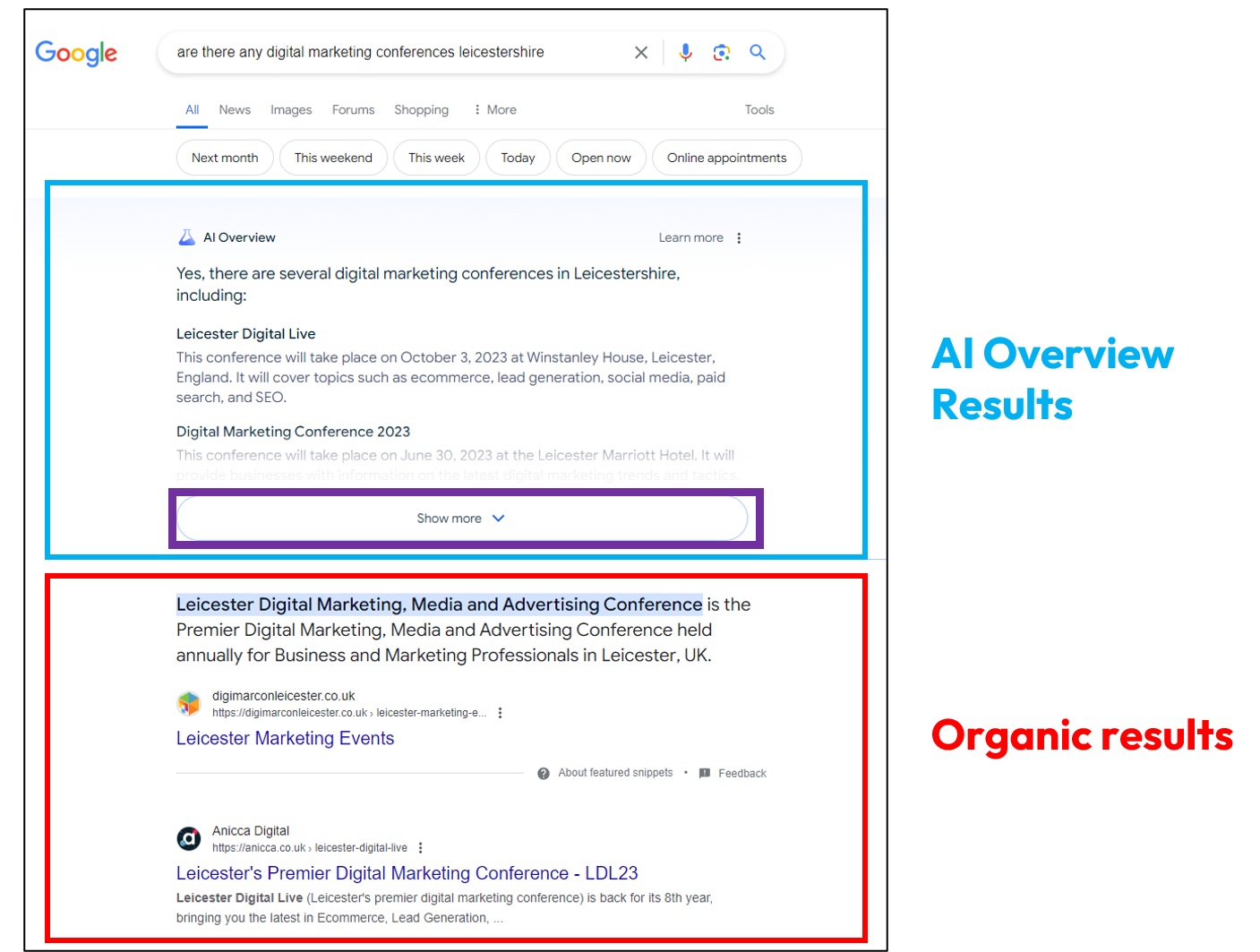

ChatGPT 4 ability’s to access data from the web and the launch of ChatGPT4o
ChatGPT initially provided answers from its training data, which meant answers were limited to the last update of the LLM. (At the time of writing the training data for ChatGPT 4 was last updated in December 2023.)
Since March 2023, users of the paid version (ChatGPT Pro) could get live access to websites via plugins. These have since been replaced by Custom GPTs and more recently by native access to the web e.g. by requesting within your prompt in ChatGPT4 “to go online”.
On May 13th, ChatGPT made a major breakthrough. Their first Multi-modal or “Omni” ChatGPT4o and their new browser upgrade had search engine functionality for the first time.
These AI-powered tools provide more engaging and user-friendly search experiences. Not only by combining voice, text, and image data, but also because they connected directly to the web. That meant they could access up-to-date data. The data is usually of high quality. The results also show the source, so you can follow the link to the original content.
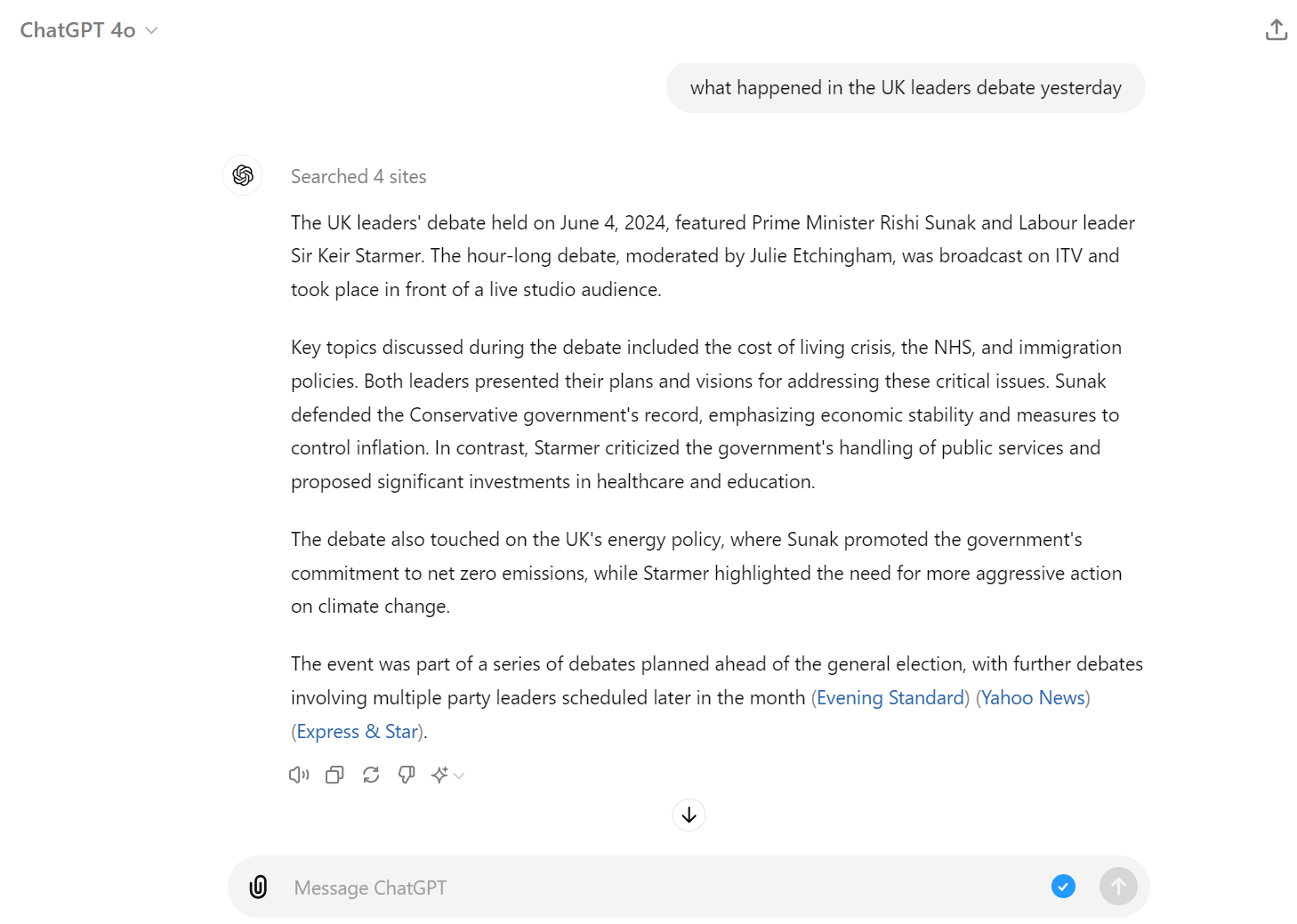
Generative Search Optimisation (GSO) – how to get found in ChatGPT, Gemini, AI Overviews and other Generative AI results
As data within generative AI results is highly collated, products or services displayed are often from well-known brands. This raises the question of how SEO professionals can get their websites into these search results without relying on PPC.
I have termed this new branch of SEO “Generative Search Optimisation or GSO.” Other authors have called it “Large Language Model Optimisation” (LLMO), “Generative AI Optimisation” (GAIO), or “Answer Engine Optimisation” (AEO).
Separately Neil Patel identifies six factors to consider when trying to get your site found in ChatGPT. He offers Brand Mentions, Reviews, Relevancy, Age, Recommendations, and Authority.
The key elements of SGO
My diagram below, shows how you can improve your website’s visibility in AI-generated answers by making sure your content is part of large language models (LLMs), i.e. the data used to train them. Since these tools can now search the web directly, you will need to use SEO strategies and invest in paid directories or being listed in important resources like Wikipedia, which may be used when using Retrieval-Augmented Generation (RAG) data.
The sources of Generative AI data and the process of GSO are visualised below:
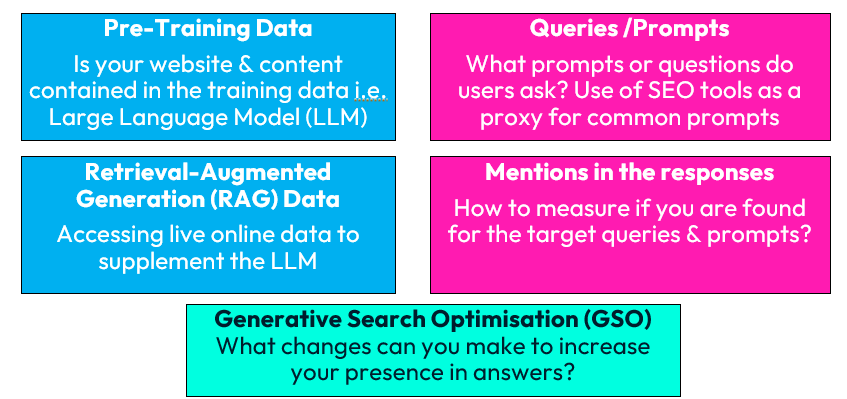
1) Pre-Training Data:
This includes content from the web and other sources that are incorporated into the training data of Large Language Models (LLMs). Collected up to a specific date, this data is used to generate AI responses.
2) Retrieval-Augmented Generation (RAG) Data:
Access live online data to supplement the LLM, enhancing the relevance and accuracy of the content generated by AI.
3) Queries/Prompts:
Using SEO tools as a proxy for common prompts to identify the most frequent prompts.
4) Mentions in the Responses:
Measure if your website or content is found in AI-generated responses for the target queries and prompts, to track your visibility.
5) Generative Search Optimisation (GSO):
Implement changes to increase your website’s presence in AI-generated answers by ensuring your content is included in large language models (LLMs).
Use SEO strategies and consider inclusion in paid directories or key resources like Wikipedia, which are often accessed when using Retrieval-Augmented Generation (RAG) data.
In the coming years, SEO job roles and activities are likely to undergo significant changes to accommodate these new GSO optimisation methods.
How does paid search fit into this AI world?
Paid search in AI Overview results
Many people suspected that SGE results would include ads, so that links there could generate revenue. This was based on the reasoinable assumption that if Google was going to give the answers to users’ questions, they would reduce their own earnings as well as clicks to publishers and business websites.
Shortly after AI Overviews was launched, it was confirmed that text and shopping ads would be included.
Increase in demand and costs for paid search
According to Tinulti’s 2024 Q1 Report increased demand for paid search ads has resulted in a 14% year on year increase in CPCs. One of the biggest drivers of this increase has been spend by Temu, driving up costs in many consumer sectors.
Demand for paid search traffic is likely to increase further as AI Overviews drives competition for visibility. Likewise because users no longer need to click through to the source website to retrieve answers (known as “Zero Click searches.”)
Keyphrase redundancy in paid search and the role of on-page optimisation
Ad platforms are using more automation and are consequently moving away from traditional text or search campaigns. These are where you need to select your own keyphrases for use in ads (I have called this “Keyphrase Redundancy”).
Instead Google, and other platforms that offer search functionality, often use your website content (or content in your feed), to determine if your ad will be shown. The main triggers for search ads are shown in the diagram below.
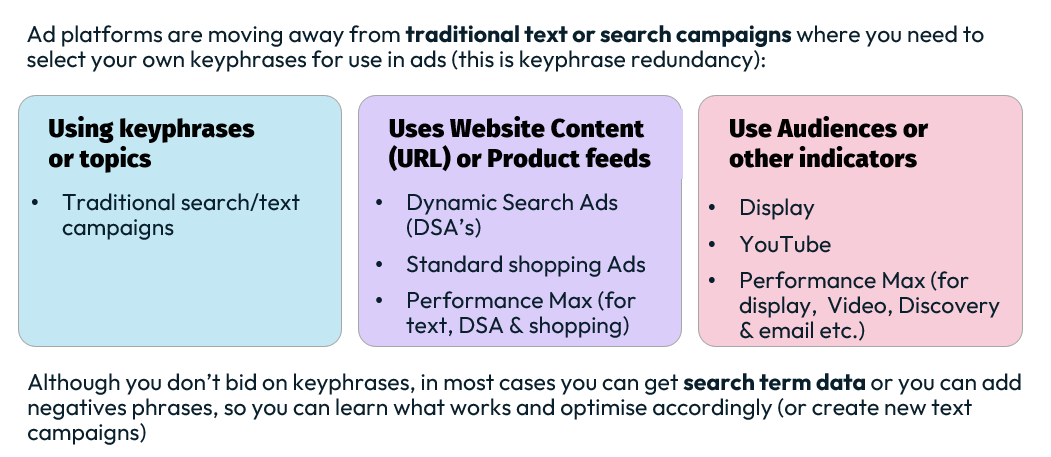
Even if you don’t bid on keyphrases, you can usually see search term data or add negative phrases. These allow you to find out what works and improve it (or make new text campaigns.)
The search term data gathered from your paid search campaigns can also be used to optimise your content for SEO purposes, or other search-based campaigns away from search engines. For example in Amazon, TikTok or Pinterest (see diagram below).
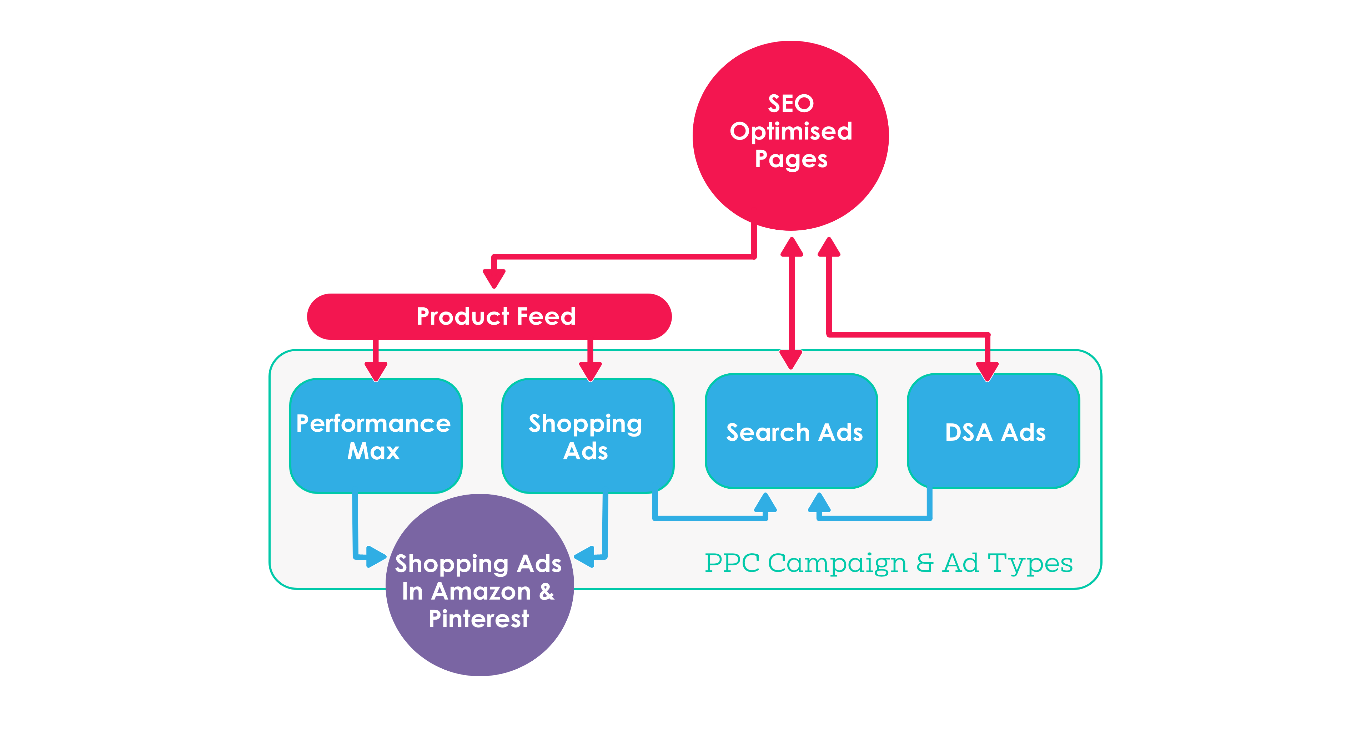
I propose that we should apply SEO to improve PPC landing pages and make them more suitable for paid search, as well as to enable the SEO and PPC teams to collaborate more effectively and leverage the insights and tools that are meant for these distinct (isolated) aspects of search marketing. However, this is part of a broader integration of strategies based on the concept of “search as an action rather than a platform.”
Optimising for the Future – integration of PPC, SEO and GSO
As AI and social search reshape the digital landscape, businesses must adapt their strategies to maintain visibility and drive traffic.
Key actions include:
- Diversifying Search Strategies: Incorporate multiple platforms, to reach a broader audience during their search journey; including emerging search engines like Perplexity and Brave and social search like TikTok and Reddit.
- Embracing Generative AI and use of GSO: Optimise content and use of GSO strategies to increase visibility in AI-driven search results, such as ChatGPT4o, Google AI Overviews, Bing, and Perplexity etc.
- Integrating SEO, PPC and GSO: Develop cohesive strategies that align SEO or GSO activities with paid search campaigns, to maximise traffic from all platforms, irrespective of where the search is carried out.
Conclusions
The integration of Generative AI and social search is transforming the landscape of online search and consumer behaviour. While Google remains a dominant force, the emergence of platforms like TikTok, ChatGPT, and other AI-driven tools are reshaping how consumers find information and products. Businesses must adapt by diversifying their search strategies, embracing Generative Search Optimisation (GSO), and integrating SEO, PPC, and GSO activities to maintain visibility and drive traffic from various platforms. By staying informed and proactive, companies can leverage these innovations to achieve sustained commercial success.




